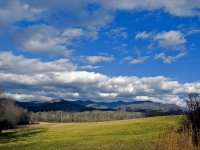MacDaddy
Certified Machead
The first is easy; the second is NOT! I'm COMPLETELY frustrated with my digital experiences to date, despite having some decent equipment (Olympus E-1 w/pro-level lenses). Since most of my photography is landscape, I believe a move on up to medium format is probably the wisest thing to do, Leica M8 lusts notwithstanding.
Here's the dilema—do I bite the bullet, go insanely into hock and get an ALPA TC with the new 36mm/5.6 Switar and kiss about $7,500 USD goodbye, PLUS go back to the hassles (and costs!) of film, finding a good lab to process medium format (and no, I do NOT have the space or ability to do that myself, durn it!) and adjusting my digital workflow to include scanning 6X9 negs and THEN figuring out how I want to print them, or do I wait to see what's coming at PMA in MArch and hope for a better and more affordable digital solution or invest in something like the M8 and ONE good lens whenever Leica settles down and fixes its issues? (And there are a number of pro photographers I've corresponded with who REALLY think there are serious issues with the Leica as a digital platform right now and who've told me to avoid it like the plague!)
Please understand; I LOVE the rangefinder experience (thus, the ALPA) and full manual control of the processes vs. dumb automation (yes, even with the M8 there is SOME! Sorry Jorge!) and the quality with the ALPA combo is breathtaking, judging from the photos I've held in my hands.
What are my options here, ladies and gentlemen? The goal is the very best photos possible with whatever system I use and the capability to do 16 X 20 fine art prints so I can hopefully sell some and recoup my costs at a minimum. Let the flaming hot responses begin!
Thanks for your input!
Here's the dilema—do I bite the bullet, go insanely into hock and get an ALPA TC with the new 36mm/5.6 Switar and kiss about $7,500 USD goodbye, PLUS go back to the hassles (and costs!) of film, finding a good lab to process medium format (and no, I do NOT have the space or ability to do that myself, durn it!) and adjusting my digital workflow to include scanning 6X9 negs and THEN figuring out how I want to print them, or do I wait to see what's coming at PMA in MArch and hope for a better and more affordable digital solution or invest in something like the M8 and ONE good lens whenever Leica settles down and fixes its issues? (And there are a number of pro photographers I've corresponded with who REALLY think there are serious issues with the Leica as a digital platform right now and who've told me to avoid it like the plague!)
Please understand; I LOVE the rangefinder experience (thus, the ALPA) and full manual control of the processes vs. dumb automation (yes, even with the M8 there is SOME! Sorry Jorge!) and the quality with the ALPA combo is breathtaking, judging from the photos I've held in my hands.
What are my options here, ladies and gentlemen? The goal is the very best photos possible with whatever system I use and the capability to do 16 X 20 fine art prints so I can hopefully sell some and recoup my costs at a minimum. Let the flaming hot responses begin!
Thanks for your input!


